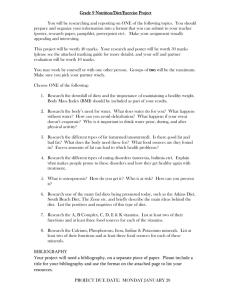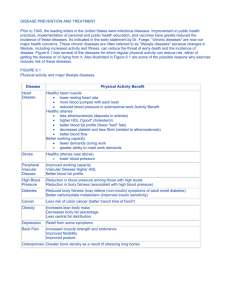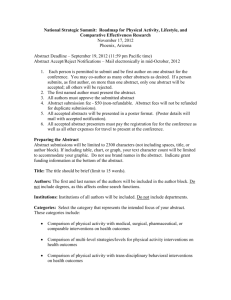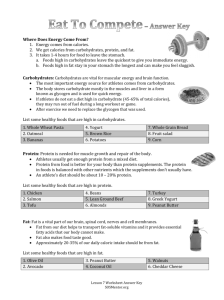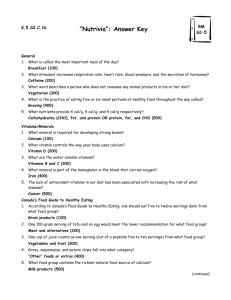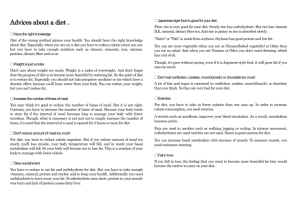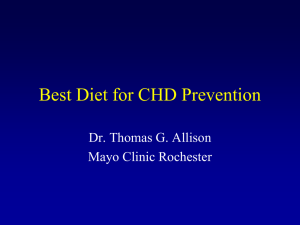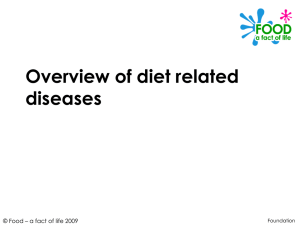Q1. Obesity is a factor that affects Coronary Heart Disease (CHD). (a
advertisement
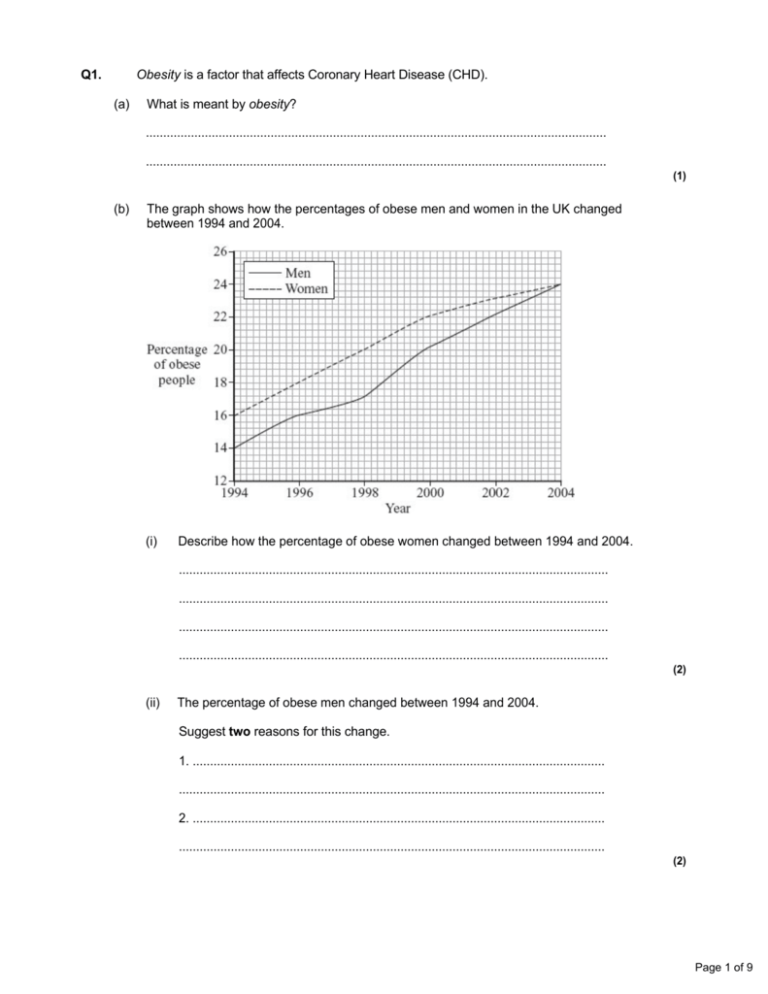
Q1. Obesity is a factor that affects Coronary Heart Disease (CHD). (a) What is meant by obesity? ..................................................................................................................................... ..................................................................................................................................... (1) (b) The graph shows how the percentages of obese men and women in the UK changed between 1994 and 2004. (i) Describe how the percentage of obese women changed between 1994 and 2004. ............................................................................................................................ ............................................................................................................................ ............................................................................................................................ ............................................................................................................................ (2) (ii) The percentage of obese men changed between 1994 and 2004. Suggest two reasons for this change. 1. ....................................................................................................................... ........................................................................................................................... 2. ....................................................................................................................... ........................................................................................................................... (2) Page 1 of 9 (c) The chart below is published by the British Heart Foundation. It shows how death from CHD is related to a number of different factors. copyright National Heart Forum Each factor is represented by a circle. The bigger the circle, the more people are affected by the factor. (i) What is the main factor causing death from CHD? ........................................................................................................................... (1) (ii) Estimate the percentage of deaths from CHD related to high blood pressure. .................................................. % (1) (iii) The data are shown as overlapping circles instead of a bar chart. The percentages of deaths related to the different factors add up to more than 100%. What does this tell you about some of the people who died from CHD? ........................................................................................................................... ........................................................................................................................... (1) (Total 8 marks) Page 2 of 9 Q2. A popular diet book claims that a low-carbohydrate diet results in quicker weight loss and a more healthy body than a low-fat diet. Scientists carried out an investigation to see if this claim is true. • They used 120 overweight volunteers divided into two equal groups. • Group 1 was given a diet containing less than 20 g of carbohydrate per day. • Group 2 was given a low-fat diet. This contained less than 30% of energy from fat and less than 300 mg of cholesterol per day. • Both groups were given the same exercise programmes and a weekly information meeting. • Both groups were allowed only 2000 kilocalories per day. The results after 24 weeks are shown in the table. Group 1 Low-carbohydrate diet Group 2 Low-fat diet 76% 57% Mean change in body mass −12.9% −6.7% Mean change in body fat mass −9.4 kg −4.8 kg Mean change in blood HDL concentration +55 mg per litre −16 mg per litre Mean change in blood LDL concentration +16 mg per litre −74 mg per litre Proportion of volunteers who completed the trial (a) What was the independent variable in this investigation? .................................................................................................................................... (1) (b) Give one variable that the scientists tried to control in this investigation. .................................................................................................................................... (1) (c) Give two ways in which the method used by the scientists could have led to unreliable data. 1 ................................................................................................................................. .................................................................................................................................... 2 ................................................................................................................................. .................................................................................................................................... (2) Page 3 of 9 (d) Does the data support the claim in the book? Draw a ring around your answer. Yes / No Give two reasons for your answer. 1 ................................................................................................................................. .................................................................................................................................... 2 ................................................................................................................................. .................................................................................................................................... (2) (Total 6 marks) Q3. Many people who are overweight try slimming programmes. A research study evaluated four different slimming programmes over 6 months. Scientists selected a group of 40 people for each slimming programme and a control group. Each of the five groups was matched for age, gender and mass. The graph shows the results of the study. Adapted from British Medical Journal, 2006, volume 332, pages 1309 –1314. (a) Give two control variables that were used in this study. 1 .................................................................................................................................. 2 .................................................................................................................................. (2) Page 4 of 9 (b) Give two conclusions that can be drawn from the results of this study. 1 .................................................................................................................................. ..................................................................................................................................... 2 .................................................................................................................................. ..................................................................................................................................... (2) (c) The costs of the four programmes were: • • • • Atkins book cost £3 Rosemary Conley classes cost £140 for 6 months Weight Watchers classes cost £170 for 6 months Twice-daily Slim-Fast meal replacements cost £240 for 6 months. Use this information and the graph to answer this question. Which is the most cost effective of the four programmes? ..................................................................................................................................... Explain the reason for your answer. ..................................................................................................................................... ..................................................................................................................................... ..................................................................................................................................... ..................................................................................................................................... (2) (d) Some slimming programmes include daily exercise. Explain how daily exercise helps a person to lose mass. ..................................................................................................................................... ..................................................................................................................................... ..................................................................................................................................... ..................................................................................................................................... (2) (Total 8 marks) Page 5 of 9 M1. (a) being overweight do not accept fat unqualified allow BMI over 25 1 (b) (i) rose 1 by 8% / from 16% to 24% / by 50% / rapidly then more slowly 1 (ii) any two reasonable suggestions e.g. less active accept e.g.s like fewer jobs / more cars / less physically demanding employment OWTTE more food / take-aways / fast food 2 (c) (i) high (blood) cholesterol do not accept combination of 2 labels ignore references to LDL and HDL 1 (ii) answer in range 8-17 inclusive 1 (iii) some deaths related to more than one factor 1 [8] M2. (a) diet or description 1 (b) exercise or group meetings or same number of kilocalories per day or time or group size 1 Page 6 of 9 (c) any two from: eg • scientists didn’t observe amount of exercise or volunteers cheated on exercise(*) • scientists didn’t observe the amount of food or volunteers cheated on food(*) (*)if no marks awarded for first 2 bullet points allow don’t stick to plan or cheated for 1 mark • mass of subjects not controlled • age of subjects not controlled • gender of subjects not controlled • occupation of subjects not controlled • different proportions of subjects completed course allow not all completed course • low number of subjects ignore not repeated 2 (d) any two from: (yes) • low carbohydrate / Group 1 / people / they lost more mass ignore more people lost weight allow greater change in mass • low carbohydrate / Group 1 / people / they lost more body fat ignore more people lost body fat allow greater change in body fat • low carbohydrate diet / Group 1 / people / they resulted in more HDL allow better HDL to LDL balance allow greater change in HDL 2 [6] M3. (a) any two from: • age • gender • mass • number in group • time 2 Page 7 of 9 (b) any two from: • highest (mean) mass loss on Rosemary Conley or Rosemary Conley most effective • least (mean) mass loss in control group or mean 2 (c) (Atkins) costs least 1 mass loss very similar to other diets or second highest mass loss or as effective as other diets 1 (d) any two from: • (exercise) increases metabolic rate / respiration ignore sweating • (exercise) needs / uses energy / calories allow burns fat / calories do not accept energy for respiration • (this) energy comes from food / fat • less food / energy/ calories converted to fat 2 [8] Page 8 of 9 Page 9 of 9
